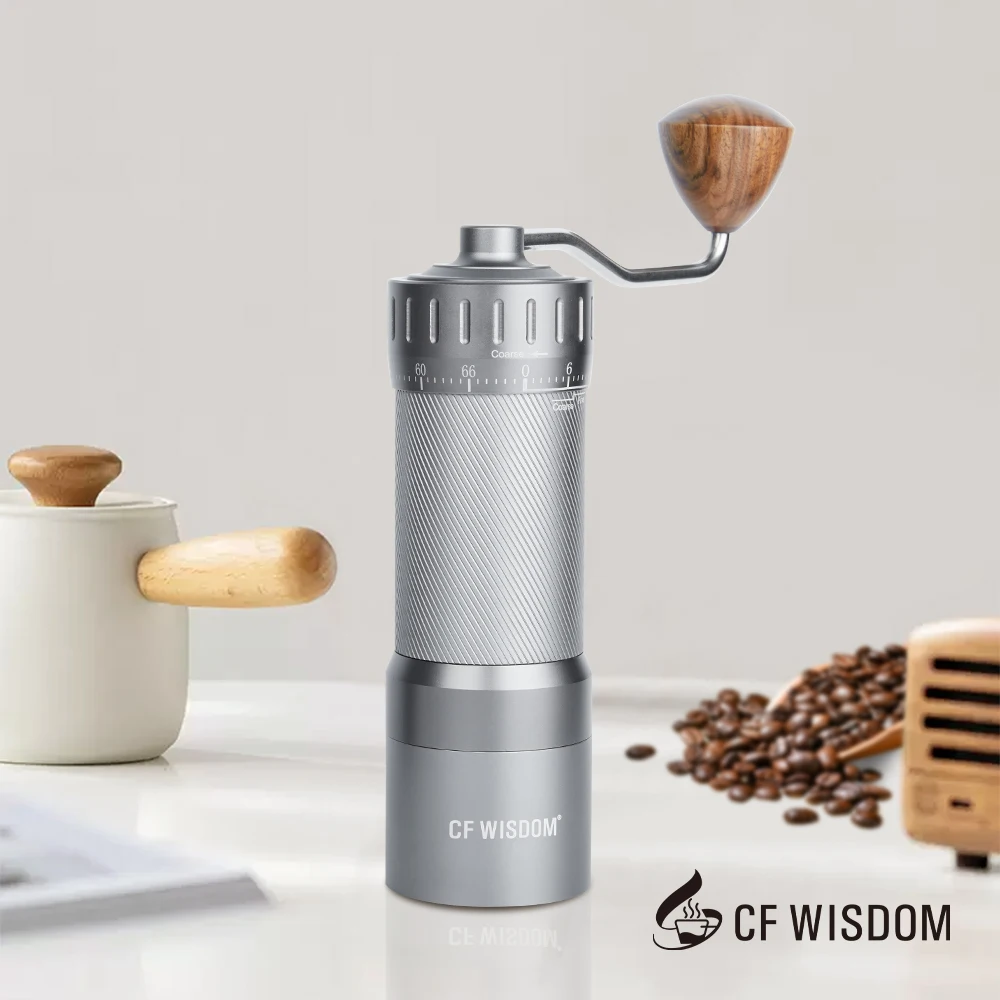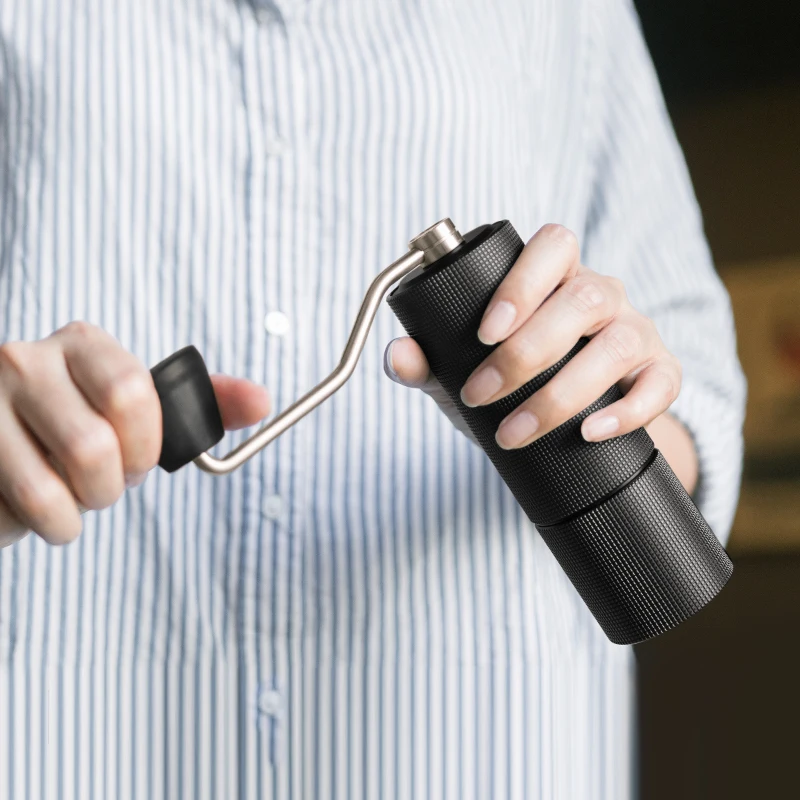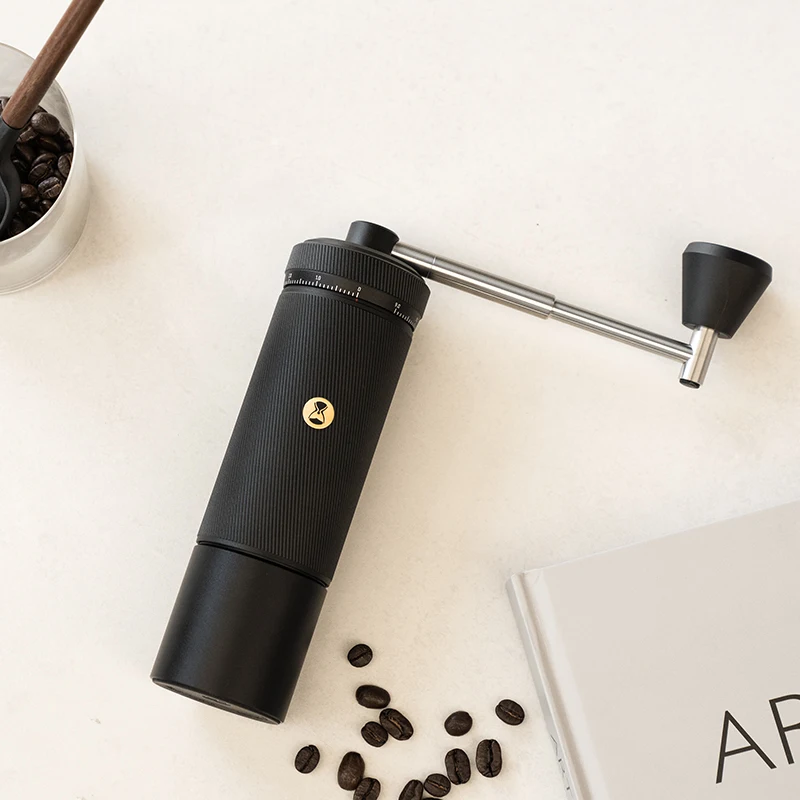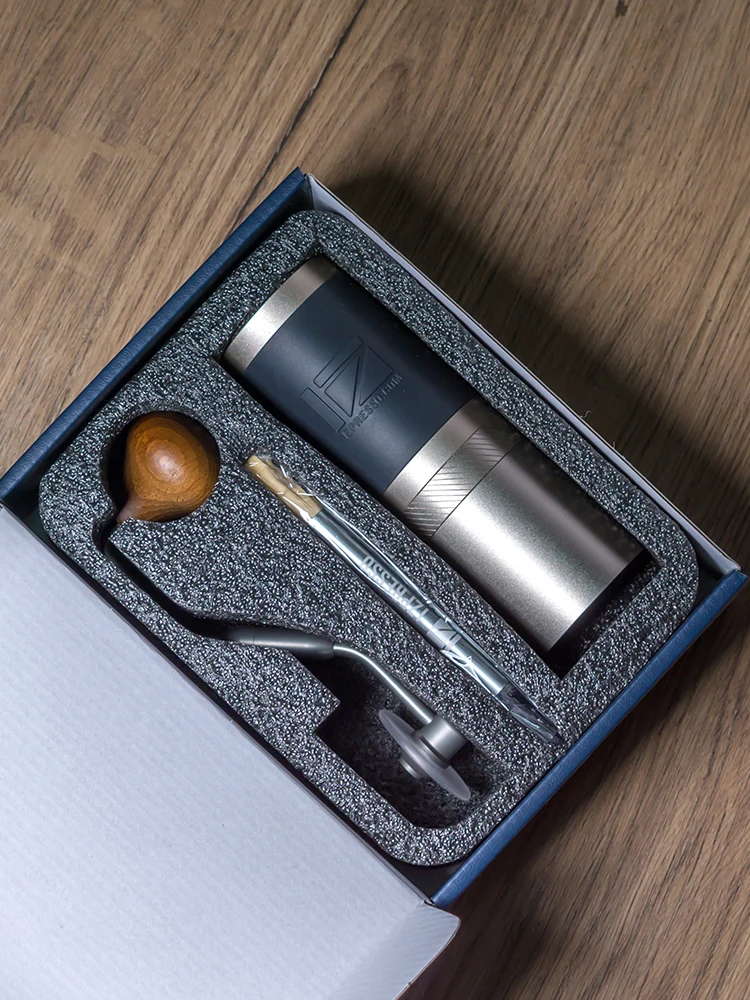What is Grind Particle Uniformity and Why Does It Matter?
Grind particle uniformity refers to how consistently sized your coffee grounds are after grinding. In simple terms, it’s about getting coffee particles that are all roughly the same size, rather than a mix of large chunks and fine dust.
This uniformity is critically important for brewing great coffee because water extracts flavor from coffee grounds at different rates depending on their size:
- Small particles (fines) extract quickly and can lead to bitterness
- Large particles (boulders) extract slowly and can create sourness
- Uniform particles extract at the same rate, creating balanced flavor
When we talk about coffee grinding, we typically identify three main particle types:
– Fines: Powdery particles that over-extract quickly
– Target particles: The ideal size we’re aiming for
– Boulders: Large chunks that under-extract
Flat burr systems are particularly valued for their ability to produce uniform particles because of their parallel grinding surfaces that create a more consistent grinding path. This design advantage directly translates to more even extraction, which professional baristas aim to keep within the ideal range of 18-22% of coffee solubles.
The journey toward coffee perfection begins with understanding how coffee burr size and uniformity directly impact the quality of your final brew. The foundation of exceptional coffee extraction relies on concepts that are thoroughly explored in our superior coffee definitive guide.
The Mechanics of Flat Burr Grinders: How They Create Uniform Particles
Flat burr grinders feature two parallel disc-shaped burrs that work together to precisely cut coffee beans into consistent particles. The key components include:
- A stationary lower burr fixed to the grinder body
- A rotating upper burr driven by the motor
- An adjustment mechanism to control the distance between burrs
- A motor or hand crank that powers the grinding action
When grinding begins, beans are fed between these parallel discs where they’re gradually broken down. The coffee moves from the center of the burrs outward due to centrifugal force, traveling through progressively smaller spaces between the burrs.
What makes flat burrs special is their cutting action. Rather than crushing beans (which creates inconsistent particles), the sharp edges of the burrs precisely slice the beans into increasingly smaller pieces. This produces a more uniform grind because:
- The parallel orientation ensures beans experience consistent pressure
- The cutting edges create clean breaks rather than crushing
- The beans follow a predictable path through the grinding zone
This grinding approach produces what coffee experts call a “unimodal distribution” – most particles cluster around the target size with fewer outliers. In contrast, some other grinding methods create “bimodal distribution” with significant quantities of both large and small particles.
Understanding the mechanics of manual flat burr grinders provides insight into how these precision tools operate. Many coffee enthusiasts carefully evaluate the differences between flat and conical burr manual grinders when selecting equipment for their brewing needs.
The Science Behind Grind Uniformity: Particle Size Distribution
Particle Size Distribution (PSD) is the scientific measurement of how coffee ground sizes are distributed after grinding. This distribution directly impacts extraction quality and is typically measured in microns (1/1000 of a millimeter).
Key metrics used to evaluate particle distribution include:
- Median particle size: The middle value in the range of all particles
- Distribution width: How widely particle sizes vary from the median
- Percentage of fines and boulders: The proportion of particles outside the target range
In coffee brewing, different methods require specific particle size ranges:
– Espresso typically needs 200-500 microns
– Pour-over methods work best with 500-800 microns
– French press performs well with 800-1000 microns
The precise impact of particle size variation can be significant:
- Fines (particles under 100 microns) extract rapidly and can clog filters, slowing down flow rate and over-extracting. This leads to bitter, astringent flavors.
- Boulders (particles significantly larger than the target size) extract too slowly, creating channels where water rushes through gaps rather than extracting evenly. This causes sourness and weak flavor notes.
An ideal distribution curve would show a tight clustering around the target particle size with minimal outliers on either end. In contrast, a poor distribution shows multiple peaks or a wide, flat curve indicating inconsistent grinding.
For those serious about precision grinding, our selection of flat burr hand grinders offers the engineering needed to achieve consistent results.
Burr Design and Geometry: Foundation of Uniformity
The specific design and geometry of coffee burrs fundamentally determine grind uniformity. The cutting edges are arranged in patterns that influence how beans break down as they move through the grinding chamber.
Key burr design elements include:
- Cutting edge patterns: The arrangement and number of teeth affect how beans are sliced
- Pre-breakers: Initial teeth that break beans into manageable pieces
- Finishers: The outer section of burrs where final sizing occurs
Common burr designs that affect uniformity include:
- Flat burrs with standard teeth: Traditional design with straight cutting edges
- Ghost teeth: Modified patterns with additional cutting surfaces
- Hybrid designs: Combining multiple tooth geometries for specific grinding profiles
Burr diameter significantly impacts grinding consistency, with larger burrs (typically 50-90mm or 2-3.5 inches) generally providing better uniformity. This improvement comes from:
- Greater surface area for cutting
- More cutting edges engaged simultaneously
- Lower RPM requirements for the same grinding speed
- Better heat dissipation during grinding
The angle of the cutting teeth also matters—sharper angles produce cleaner cuts but may dull faster, while more obtuse angles offer durability but potentially less precision.

Understanding how burr shape affects espresso consistency is particularly important for those seeking perfect extractions.
Burr Materials and Manufacturing: Impact on Grinding Performance
The materials used in burr construction fundamentally affect grinding performance, durability, and ultimately, particle uniformity.
| Burr Material | Hardness | Durability | Heat Management | Effect on Uniformity |
|---|---|---|---|---|
| High-Carbon Steel | High (58-62 HRC) | Excellent | Average | Very consistent cuts, prone to rusting |
| Stainless Steel | Good (54-58 HRC) | Very Good | Good | Consistent performance, corrosion resistant |
| Ceramic | Very High (70+ HRC) | Good (brittle) | Excellent | Stays sharp longer, can chip if dropped |
Manufacturing processes also play a crucial role in burr quality:
Machined burrs are precision-cut from solid metal blocks, offering tighter tolerances and better uniformity. These typically provide superior particle consistency but at higher cost.
Cast burrs are formed by pouring molten metal into molds. While more economical, they may have less precise cutting edges and potentially more variation between individual burrs.
Specialty coatings like titanium nitride can further improve performance by:
– Reducing friction during grinding
– Enhancing durability of cutting edges
– Providing smoother bean flow through the burrs
The precision of manufacturing directly affects alignment capabilities—burrs made with stricter tolerances will maintain better parallelism, which is essential for uniform grinding.
For those seeking equipment with exceptional manufacturing standards, our collection of precision manual grinders emphasizes quality materials and construction.
Alignment and Concentricity: The Critical Factors for Consistency
Perfect alignment between burrs is perhaps the single most important factor for achieving uniform grinding results. When we talk about alignment, we’re referring to two critical aspects:
Parallelism: The grinding surfaces must be perfectly parallel to each other across their entire surface. Even tiny deviations of 0.01mm (one-hundredth of a millimeter) can cause:
– One section of the burrs to produce finer particles than another
– Inconsistent resistance during grinding
– Uneven wear over time
Concentricity: The burrs must share the same center point and rotate without wobble. Poor concentricity causes:
– Oscillating distance between burrs during rotation
– Pulsing grind size as the burrs rotate
– Premature wear on certain sections
Signs of misalignment issues include:
– Inconsistent grind size visible to the naked eye
– Audible changes in grinding noise (rhythmic pulsing)
– Noticeably uneven extraction in your brewed coffee
– One side of the burr showing more wear than others
Manufacturing tolerances directly impact alignment potential. Professional-grade grinders typically maintain tolerances of +/- 0.005mm or better, while lower-quality grinders might have tolerances ten times looser.
For consistent daily brewing results, learning techniques for achieving uniform grinds with manual burrs can significantly improve your coffee experience.
Motor Performance and Heat Management: Overlooked Uniformity Factors
While often overlooked, motor performance and heat generation play significant roles in grind quality, especially during longer grinding sessions.
Typical flat burr grinders operate within specific RPM ranges:
– Home grinders: 400-1200 RPM
– Commercial grinders: 900-1600 RPM
These speeds directly impact grinding consistency:
- Higher speeds can process coffee more quickly but generate more heat and potentially create static electricity that causes grounds to clump
- Lower speeds generally produce less heat but require more time to grind the same amount of coffee
Heat affects uniformity through several mechanisms:
– Expanding metal components, potentially changing alignment
– Altering the moisture content of beans during grinding
– Prematurely releasing volatile compounds, affecting flavor
– Melting oils in the coffee, creating more clumping and adhesion
During extended grinding sessions, temperatures can increase by 30-50°F (17-28°C), which is enough to noticeably impact flavor compounds and extraction characteristics.
Effective cooling approaches include:
– Aluminum heat sinks to dissipate heat
– Built-in cooling fans in higher-end models
– Programmed rest periods during high-volume grinding
– Lower RPM motors that generate less friction heat
For those seeking consistent temperature control, our collection of manual coffee burr grinders offers solutions that eliminate motor-generated heat entirely.
Burr Sharpness and Seasoning: Evolution of Grinding Performance
The sharpness of burr cutting edges directly impacts particle uniformity, while the seasoning process creates subtle but important changes to new burrs.
Sharp burrs create uniformity by:
– Cleanly slicing beans rather than crushing them
– Producing fewer fines and micro-particles
– Requiring less pressure to achieve proper grinding
– Creating more consistent particle shapes
As burrs begin to dull, their performance changes:
– Cutting becomes less precise, leading to more crushing
– Fines production increases
– Heat generation rises due to increased friction
– Grind times lengthen for the same quantity of coffee
Burr seasoning refers to the natural process where new burrs slightly wear from their factory-fresh state to an optimal cutting condition. This process:
– Removes microscopic manufacturing burrs and imperfections
– Creates smoother cutting surfaces
– Typically requires grinding 5-10 pounds of coffee
– Results in more consistent performance after completion
Signs that your burrs may need replacement include:
– Noticeably longer grinding times
– Increased heat production during grinding
– More visible fines in your ground coffee
– Less clarity in brewed coffee flavor
– Difficulty achieving target grind sizes
Most quality burrs will process between 500-1500 pounds of coffee before requiring replacement, though premium options may last significantly longer.

Our selection of hand burr grinders features replaceable burr sets to maintain peak performance throughout your coffee journey.
Bean Variables: How Coffee Characteristics Affect Grinding Uniformity
Even with perfect grinder alignment and sharp burrs, the coffee beans themselves introduce variables that affect grinding consistency.
Density variations: Coffee beans grown at different altitudes develop varying densities:
– High-altitude beans (typically harder and denser) resist fracturing and may require finer grinder settings
– Low-altitude beans (typically softer) break down more easily and may produce more fines at the same setting
Roast levels dramatically change grinding behavior:
– Light roasts are dense and brittle, requiring more force to grind and producing fewer fines
– Medium roasts offer balanced grinding properties with moderate density
– Dark roasts are brittle but less dense, breaking down easily and often creating more fines
Processing methods affect bean structure:
– Washed coffees typically have cleaner, more consistent density
– Natural (dry) processed coffees can have more varied density throughout the bean
– Honey processed beans fall somewhere between, with moderate consistency
Age of coffee after roasting:
– Very fresh coffee (1-7 days) contains more gases that can create inconsistent grinding resistance
– Properly rested coffee (7-21 days) typically grinds more consistently
– Older coffee becomes increasingly brittle and may produce more fines
Understanding these variables helps explain why you might need different grinder settings for different beans, even when brewing with the same method. The relationship between flat burrs and extraction is explored further in our article on flat burr uniform extraction.
Measuring and Assessing Grind Uniformity: From Visual Inspection to Scientific Analysis
For coffee enthusiasts seeking to evaluate grind uniformity, several methods are available ranging from simple visual techniques to sophisticated scientific approaches.
Basic Visual Inspection:
1. Place a small amount of ground coffee on a dark, non-reflective surface
2. Spread the grounds thinly with a card or ruler
3. Examine under good lighting, looking for obviously different-sized particles
4. Check for clumping, which often indicates excessive fines
Simple Sifting Analysis:
1. Use fine kitchen sieves of different mesh sizes
2. Weigh a sample of ground coffee (typically 10 grams)
3. Sift through progressively finer screens
4. Weigh the amount captured by each screen to calculate percentage distributions
Practical Brewing Indicators:
– Consistent extraction times across multiple brews using the same parameters
– Even flow rate throughout pour-over brewing
– Absence of channeling in espresso pucks
– Clear, clean cup flavor without simultaneous sourness and bitterness
Professional and scientific approaches include:
– Laser diffraction analysis to precisely measure particle distribution
– Image analysis software that counts and measures thousands of particles
– Sieve towers with standardized mesh sizes for comparative testing
For good uniformity in home brewing, aim for:
– At least 60% of particles clustered around your target size
– No more than 10-15% fines for most brewing methods
– Less than 5% significantly oversized particles
These measurements provide actionable feedback to adjust grinding approach and equipment maintenance for better brewing results.
Our manual burr mill collection offers tools with excellent uniformity characteristics for home brewing applications.
Grind Uniformity’s Impact on Different Brewing Methods
Each coffee brewing method has its own requirements for grind uniformity, directly impacting the quality of extraction and final cup flavor.
| Brewing Method | Ideal Uniformity Profile | Impact of Poor Uniformity | Flavor Indicators of Good Uniformity |
|---|---|---|---|
| Espresso | Extremely uniform, very few boulders | Channeling, inconsistent flow rate, “gushers” or “chokers” | Balanced sweetness, absence of both sourness and excessive bitterness |
| Pour Over | Highly uniform medium grind | Uneven drawdown, clogging, inconsistent extraction | Clean cup, defined flavor notes, proper extraction time (2:30-3:30) |
| French Press | Uniformly coarse with minimal fines | Muddy cup, silt, harsh bitterness from fines | Clear separation between liquid and grounds, full body without muddiness |
| AeroPress | Moderate uniformity (method is forgiving) | Inconsistent press resistance, variable strength | Repeatable results, consistent pressing resistance |
For espresso particularly, uniformity is critical because:
– Water follows the path of least resistance through the puck
– Any inconsistency creates channeling where water rushes through larger gaps
– Extraction happens under pressure, magnifying any uniformity problems
– The short contact time (25-30 seconds) leaves no room for correction
Pour-over methods benefit from uniformity through:
– Consistent drawdown rates throughout the brewing process
– Even extraction across all coffee particles
– Clarity of flavor with distinct, identifiable taste notes
Even immersion methods like French press, which are more forgiving, benefit from uniform grinds by:
– Reducing silt and sediment in the cup
– Providing more consistent results between brews
– Allowing more precise brewing time control
For those focusing on espresso preparation specifically, our collection of flat burr grinders for exceptional coffee offers precision tools designed to meet these demanding uniformity requirements.

Flat vs. Conical Burrs: A Focused Uniformity Comparison
When comparing the two primary burr styles, significant differences emerge in how they produce coffee particles and the resulting flavor characteristics.
Particle Distribution Patterns:
– Flat burrs tend toward unimodal distribution (particles clustered around a single target size)
– Conical burrs typically produce bimodal distribution (a mix of target particles and a secondary smaller peak of fines)
Particle Shape Characteristics:
– Flat burrs create more disc-like, uniform particles with consistent thickness
– Conical burrs produce more irregular, three-dimensional particles with greater variance
Resulting Flavor Profiles:
– Flat burr grinds often yield brighter acidity, greater clarity, and more distinct flavor separation
– Conical burr grinds typically produce more body, rounded mouthfeel, and potentially more complexity due to varied extraction rates
Uniformity Considerations:
– Flat burrs generally achieve higher technical uniformity when properly aligned
– Conical burrs may produce more fines, but these can contribute positively to certain brewing styles
When to Choose Flat Burrs:
– Light to medium roasts where clarity and distinct flavor notes are desired
– Pour-over and filter methods where even extraction is critical
– When precision and repeatability are top priorities
The material choice between steel vs. ceramic burrs affects heat retention during grinding, which can further influence uniformity and extraction characteristics.
Fine Adjustment Hand Grinder, Precision Manual Grinder, Travel Coffee Grinder
Price range: $185.11 through $494.63 Select options This product has multiple variants. The options may be chosen on the product pageHand Burr Grinder, Hand Crank Coffee Grinder, Manual Espresso Grinder, Portable Coffee Grinder
Price range: $262.72 through $300.22 Select options This product has multiple variants. The options may be chosen on the product pageManual Burr Mill, Manual Coffee Grinder Stainless Steel, Manual Coffee Mill Grinder, Mechanical Coffee Grinder
Price range: $127.26 through $130.32 Select options This product has multiple variants. The options may be chosen on the product pageHand Burr Grinder, Manual Coffee Grinder Stainless Steel, Precision Manual Grinder
Price range: $183.64 through $187.52 Select options This product has multiple variants. The options may be chosen on the product page
Troubleshooting Common Uniformity Issues in Flat Burr Systems
Even with high-quality grinders, uniformity problems can develop over time. Recognizing and addressing these issues helps maintain optimal brewing performance.
Problem: Inconsistent extraction times
– Cause: Burr misalignment or developing wobble
– Solution: Check and reset burr alignment; inspect for loose components
Problem: Visible mix of large chunks and fine powder
– Cause: Worn burrs or improper calibration
– Solution: Replace burrs if worn; recalibrate grinder to zero point
Problem: Excessive fines production
– Cause: Dull burrs, incorrect RPM, or bean-related issues
– Solution: Replace burrs; check motor speed; adjust for bean type/roast level
Problem: “Clumping” of ground coffee
– Cause: Static electricity or excessive heat during grinding
– Solution: Use RDT (Ross Droplet Technique – adding a drop of water to beans); grind at lower speed; allow grinder to cool between batches
Problem: Channeling in espresso (fast streams through parts of the puck)
– Cause: Uneven particle distribution causing water to find easier paths
– Solution: Improve distribution in portafilter; check grinder alignment; consider WDT (Weiss Distribution Technique)
Problem: Increasing bitterness over time with same settings
– Cause: Gradual burr wear creating more fines
– Solution: Adjust grind coarser to compensate; replace burrs when adjustment no longer helps
Regular cleaning is essential for maintaining uniformity:
– Remove old coffee oils that can affect bean flow
– Clear compacted grounds from between burr teeth
– Ensure adjustment mechanisms move freely and accurately
For those focusing specifically on espresso preparation, our espresso coffee hand grinders are designed to address these common uniformity challenges.
Optimizing Your Flat Burr Grinder for Maximum Uniformity
Achieving the best possible grind uniformity requires attention to multiple factors. These steps will help you optimize performance regardless of your specific grinder model:
Alignment Optimization:
1. Start with a thorough cleaning of all burr surfaces
2. Check for any debris preventing proper burr seating
3. When reinstalling burrs, tighten mounting screws in a star pattern
4. Test alignment by marking burrs with washable marker and observing contact patterns
5. Use shims if necessary to correct any detected misalignment
Maintenance Schedule for Uniformity:
– Daily: Brush out the grinding chamber
– Weekly: Remove upper burr for thorough cleaning
– Monthly: Deep clean all components and check alignment
– Every 3-6 months: Check for burr wear and wobble
Calibration Process:
1. Carefully bring burrs to touch point (zero position)
2. Mark this position as your reference point
3. Back off to appropriate brewing range
4. Document settings for different brewing methods
Operational Best Practices:
– Allow grinder to run briefly before introducing beans
– Maintain consistent dosing amounts
– Consider single-dosing to eliminate old grounds
– Keep beans in the hopper to maintain consistent pressure
By implementing these practices, you’ll maximize the uniformity potential of your equipment, resulting in more consistent and flavorful coffee extractions.
At Savor Suite, our manual coffee grinders for espresso are designed with precision adjustment mechanisms that make this optimization process straightforward and effective.
Choosing a Flat Burr Grinder: Key Features for Optimal Uniformity
When selecting a flat burr grinder focused on particle uniformity, several key features deserve particular attention:
Essential Uniformity-Enhancing Features:
– Burr material and quality (hardened steel or ceramic)
– Precision of adjustment mechanism (stepped vs. stepless)
– Burr size appropriate for your brewing methods
– Stability of burr mounting system
– Quality of motor or hand-cranking mechanism
– Overall construction solidity
Build Quality Indicators:
– Minimal play in moving parts
– Tight manufacturing tolerances
– Quality bearings supporting grinding shafts
– Solid connection between burr and drive shaft
– Substantial weight relative to size (indicating quality materials)
Adjustment Mechanism Considerations:
– Fine adjustment resolution (more adjustment points = more precision)
– Repeatability when returning to previous settings
– Stability during grinding (no drift from vibration)
– Clear marking system for recording preferred settings
General Investment Guidelines:
– Entry level ($100-200): Basic uniformity suitable for brewing methods like French press and drip
– Mid-range ($200-500): Good uniformity suitable for most methods including basic espresso
– High-end ($500+): Excellent uniformity suitable for all methods including demanding espresso
Remember that proper alignment and maintenance can often improve a mid-range grinder’s performance to rival more expensive options. Our collection of fine adjustment hand grinders emphasizes precision control for achieving optimal uniformity.
Future Innovations in Flat Burr Technology: What’s Next for Uniformity?
The pursuit of perfect grind uniformity continues to drive innovation in flat burr technology. Several promising developments are shaping the future of coffee grinding:
Advanced Burr Materials and Coatings:
– New metal alloys offering extended edge retention
– Specialized coatings reducing friction and coffee adhesion
– Composite materials combining durability with precision
Enhanced Alignment Technologies:
– Self-aligning burr systems that maintain parallelism automatically
– Digital alignment measurement integrated into grinders
– Precision manufacturing techniques reducing tolerances to micron levels
Scientific Measurement Integration:
– Real-time particle analysis during grinding
– Feedback systems adjusting grind parameters based on measured output
– Mobile apps visualizing particle distribution from connected grinders
Innovative Drive Systems:
– Variable RPM motors optimizing speed for different coffee types
– Direct drive systems eliminating belts and gears for more precise control
– Advanced vibration dampening for improved stability during operation
The home grinder market continues to benefit from technology previously exclusive to commercial equipment. Features like ultra-precise burr alignment, temperature-controlled grinding, and sophisticated particle distribution are becoming more accessible.
This constant evolution reflects the coffee community’s growing understanding that particle uniformity isn’t just a technical specification—it’s a fundamental factor in brewing exceptional coffee that fully expresses the character of the beans.
For those seeking the current state of the art, our selection of stainless steel manual coffee grinders incorporates many recent advancements in burr technology and precision engineering.







